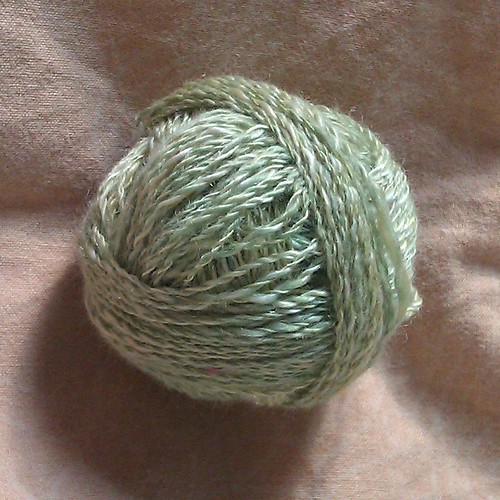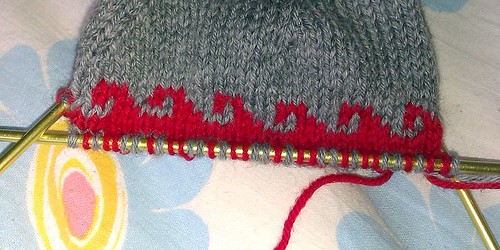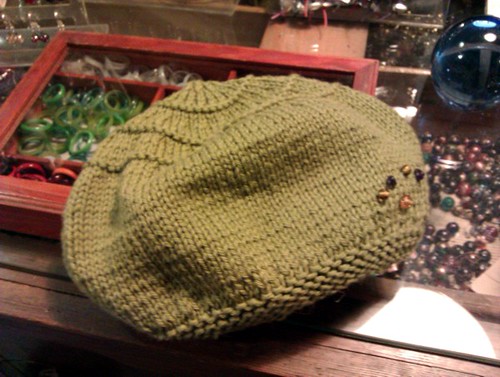And quite a knitblog. Maglia-Uncinetto.it is not a personal knitblog like this one, it's meant to become an authoritative resource on knitting and crocheting (and for all of the crafts that revolve around them) in Italy, with frequent connections to what's happening outside the "boot"'s borders and maybe a little variety and attention to other bits of life: environment, health, gender politics. Not too much, just about enough to show we don't just knit. Check it out!
September 28, 2011
September 27, 2011
On gauge and needle material
I have been involved with knitting some item for this event where I will be teaching knitting basics. I decided on a cowl and started working at it with sime unknown very gray yarn I had in my stash (looks like an undyed, so it's probabily an old ball of organic yarn from Silke by Arvier) and 5 mm needles. I started out with an Addi Turbo short circ, but I quickly grew bored by the short tips and this morning I switched to a 5 mm Denise interchangeable.
WOW! The gauge immediately changed. I am not sure if you can see it from the crappy pic (click to espand it), but after thechange, despite the fact that I knit much faster and more comfortably, the gauge must have dropped one or two sts lower (on 10 cm/4"). Not a bad thing: the cowl is now distinctly softer and the wafer texture much more pronounced, but I did not expect such important difference knitting in the same stitch pattern and in the same yarn with the same needle size, just in a diferent material.
(To learn more on the October 15 even for the homeless, check out this post.)
WOW! The gauge immediately changed. I am not sure if you can see it from the crappy pic (click to espand it), but after thechange, despite the fact that I knit much faster and more comfortably, the gauge must have dropped one or two sts lower (on 10 cm/4"). Not a bad thing: the cowl is now distinctly softer and the wafer texture much more pronounced, but I did not expect such important difference knitting in the same stitch pattern and in the same yarn with the same needle size, just in a diferent material.
(To learn more on the October 15 even for the homeless, check out this post.)
September 26, 2011
A new yarn
Say "hi" to my new spin. This is wool and silk by the Natural Dye Company. The amount is really tiny, I haven't bothered yet with weighing and measuring it but it 's a really tiny ball, and it was part of a mixed bag I got at KnitNation 2010. I have two more colors of the same blend, blue and orangey-pinkish. Overall the three colors may still be below or just around 50 grams.
This was worsted-spun on my lightest spindle and then Andean plied. The silk in the bled was just lovely, but unfortunately the wool was a bit matted so it came out a bit iregular in spots. Since I also have wool in the same hues, I considered if I ought to blend in the silk in with carders, but overall I preferred to have a silk-rich small amount of dense and shiny yarn. It probably will work better in weaving than knitting or crochet, but I will decide what to do with it once I have spun also the other two colors.
September 23, 2011
New Toys
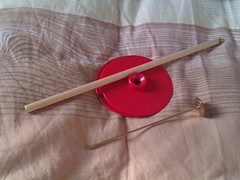
Pippa has finally returned fron the USA and she brought me a couple of new babies.
The red whorls and the hooked rod belong to a Babe's spindle: the two whorls can be adjusted to make the spindle in about each and every style that was ever created (top, bottom, middle, balkan...) and you can also use one or both whorls to modify the weight and soin speed of the spindle. I expected, though, that they would have to be worked on the shaft, instead they slide on and off very easily. I will have to add a bit of yarn to keep them in place, once I decide how I want to use it.
The smaller spindle, instead, is a takhli spindle for spinning cotton and other short-stapled (and smooth) fibers, like this. This specific takhli has a one dollar coin as a whorl, and this specific dollar depicts a Native American woman (likely from one of the eastern tribes). It looks like a sign to me!
September 16, 2011
Senape one!
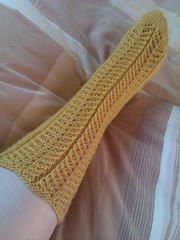 The first of the senape socks is done. I am quite satisfied with it: I almost grafted it right (only the first two sttiches are badly done) and I like the very reinforced heel. Although they are very lacy, the slightly thicker than usual yarn makes for very warm and sturdy socks, while the lace reaching the toe and constituting all of the tall cuff makes them look quite dainty. Also the lace is nice, it would have been hell if knitted back and forth, but in the round it was really easy-peasy.
The first of the senape socks is done. I am quite satisfied with it: I almost grafted it right (only the first two sttiches are badly done) and I like the very reinforced heel. Although they are very lacy, the slightly thicker than usual yarn makes for very warm and sturdy socks, while the lace reaching the toe and constituting all of the tall cuff makes them look quite dainty. Also the lace is nice, it would have been hell if knitted back and forth, but in the round it was really easy-peasy.Now, I am supposed to start working on the second Pulque sock. Point is... Where did I put the pattern? +_+
September 15, 2011
Never, never, never
Never start working on a toe first thing in the morning. Toes take more time than you'd expect. Dammit!
September 13, 2011
Socking again
Seems like I am back in the sock mood. I knitted a sock to prepare a class, then I completed a pair of socks (they took me ages, the most boring pair I ever knitted!) then I knitted the first of a new pair and new design and then I strarted the first of another new pair-new design. The Black Death Socks will likely not go anywhere because they were so boring to make that I would not invite anyone to the same deadly attempt. But it seems that the Pulque and the spicier Senape may turn out interesting. Besides, they are done in the same yarn and therefore may be a nice couple to include in a series. Maybe I should plan two more socks to go with them: something really very plain (think of ribs on the leg and boring stockinette) and something with cables, all in the same yarn. Uhm... May be interesting! Meanwhile, I will have to finish the first Senape, then work the second Pulque and revies the pattern (and have it tested!).
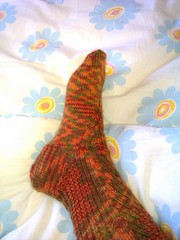 |
| Pulque |
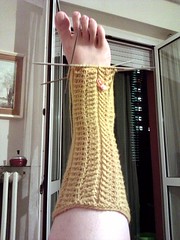 |
| Senape |
September 6, 2011
Corsi 2011
Per una volta un post in italiano, dato che è di puro interesse milanese.
Sono pronta per tre nuovi corsi, il primo in ordine di tempo si terrà il 24 settembre a Carate Brianza presso Unfilodi. Si trtterà di un laboratorio in uan giornata sul tema "Elizabeth Zimmermann e l'I-cord", durante il quale tratterò gli usi specialistici fatti da EZ del cordoncino a maglia (bordure, avvio, intreccio, occhielli e alamari, decorazioni ecc.). Conoscere già la lavorazione dell'I-cord semplice sarà gradito ma non strettamente indispensabile. Il corso costa 30 euro a persona e il prezzo comprende dispensa, filato e due brek ristoro. Per iscriversi basta visitare questa pagina, si ricorda che il corso si terrà solo al raggiungimento del numero minimo di iscritti, per cui se siete interessate, iscrivetevi al più presto.
Altri due corsi si terranno invece presso Lanar, in via Nino Bixio a Milano, il primo (tutti i mercoledì dal 28 settembre, in lezioni da due ore, 120 euro per persona) si occuperà dei calzini, nel corso infatti verrà lavorato collettivamente un paio di calzini a maglia rasata e coste con tecniche. Il secondo (5 lezioni da giovedì 29 settembre, 150 euro) è orientato alla lavorazione delle trecce, dalle più semplici fino agli intrecci Aran e alle trecce reversibili. Per informazioni e iscrizioni è possibile visitare questa pagina.
Sono pronta per tre nuovi corsi, il primo in ordine di tempo si terrà il 24 settembre a Carate Brianza presso Unfilodi. Si trtterà di un laboratorio in uan giornata sul tema "Elizabeth Zimmermann e l'I-cord", durante il quale tratterò gli usi specialistici fatti da EZ del cordoncino a maglia (bordure, avvio, intreccio, occhielli e alamari, decorazioni ecc.). Conoscere già la lavorazione dell'I-cord semplice sarà gradito ma non strettamente indispensabile. Il corso costa 30 euro a persona e il prezzo comprende dispensa, filato e due brek ristoro. Per iscriversi basta visitare questa pagina, si ricorda che il corso si terrà solo al raggiungimento del numero minimo di iscritti, per cui se siete interessate, iscrivetevi al più presto.
Altri due corsi si terranno invece presso Lanar, in via Nino Bixio a Milano, il primo (tutti i mercoledì dal 28 settembre, in lezioni da due ore, 120 euro per persona) si occuperà dei calzini, nel corso infatti verrà lavorato collettivamente un paio di calzini a maglia rasata e coste con tecniche. Il secondo (5 lezioni da giovedì 29 settembre, 150 euro) è orientato alla lavorazione delle trecce, dalle più semplici fino agli intrecci Aran e alle trecce reversibili. Per informazioni e iscrizioni è possibile visitare questa pagina.
September 5, 2011
Stranding for the English-impaired
Yes,
I am doing some stranded work It's a baby hat in very unbabylike colors ’cause I hate baby colors and ’cause I don't know if it's a boy or a girl
(actually, could have done it in pink and blue, but did I say that I
hate pink and light blue?). I am not very good at stranding, I have
worked a couple of hats with this technique and that's about all, but
it's fun to learn a new skill.
Well, I am not able to knit English style fullstop,
so the "hold one yarn in the left and the other in the right" thing would
not work for me. I have tried several types of thimbles for stranded
knitting but they don't work for me either, especially with this type of very
thin yarn (and my type of very thin fingers). In previous occasions I fought terribly to keep the two yarns
separate and moving smoothly along, but it always ended up in horrible
tangles.
But this time something new occurred.I usually knit with my own brand of Eastern Uncrossed style, but I started knitting the red yarn, sitting closer to the needles, in the regular Continental style. It works nice, the tip of the needle always goes in through the center, helping to keep the yarns separate and untangled, and the method is turning out to be faster and smoother that anything I tried before. On the next row I know that the stitches in one color will be oriented differently from the stitches in the other color, but that's fine: it's not so much different from working in Combination style! I think I could have found my own stranding style.
But this time something new occurred.I usually knit with my own brand of Eastern Uncrossed style, but I started knitting the red yarn, sitting closer to the needles, in the regular Continental style. It works nice, the tip of the needle always goes in through the center, helping to keep the yarns separate and untangled, and the method is turning out to be faster and smoother that anything I tried before. On the next row I know that the stitches in one color will be oriented differently from the stitches in the other color, but that's fine: it's not so much different from working in Combination style! I think I could have found my own stranding style.
September 1, 2011
An old new pattern
This supereasy tam was created for a beginners' class last year, and I never got around doing some editing and translating. I finally decided to make it available in both Italian and English as a Ravelry download. It's knitted flat and seamed and uses only the simplest stitches, increases and decreases. bead decoration is enterely optional. Download it now.
Subscribe to:
Comments (Atom)

